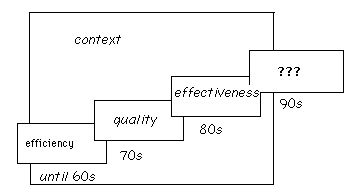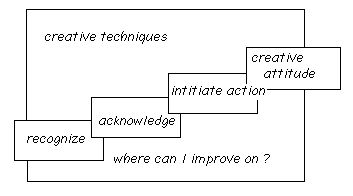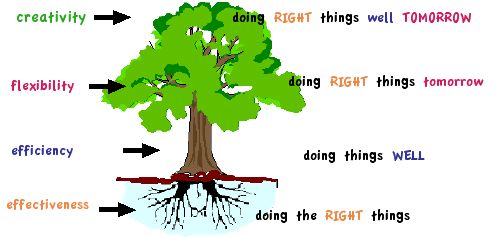
creativity
The everyday mind is the way
Soshitsu Sen XV (Tea master of Urasenke)
All creative activities - i.e. the conscious and unconscious processes- are based on one and the same universal pattern: suddenly a new combination is seen; an association is made. This basic pattern Koestler distinguishes in artistic originality (AH-experience), scientific discovery (AHA-experience) and humour (HAHA-experience). It is not easy nor interesting to distinguish between these three areas. Moreover, the results of creativity can be seen in the context of the times. So developing the creative attitude means evolving or maturing. It is a personal process which is reflected in the evolution of our environment.
For example, when we regard the industrial development, creativity was mainly directed towards efficiency until the 1960s; mass production, improving efficiency (e.g. Taylor's scientific management ). These ideas came to the fore when the times was ripe. Taylor died an unhappy man; he had to appear for a Congressional hearing on the accusation of un-American activities. The times had changed. The aim was then towards quality (Deming, Juran) and effectiveness. At all particular times the creativity was (unconsciously) directed towards the needs felt.

The efficient organization was characterized by a hierarchical, bureaucratic structure and was managed to extremely rational principles. The x-theory (see pressure) was mainly put into practice. Companies were run like machines. Creativity was used to meet the demands of the efficient organization. Later on we see the same with regard to quality, effectiveness and flexibility. An interesting case is that of Deming whose ideas on quality fell on unresponsive ears. The Japanese entrepreneurs were open to his ideas. The result was that in the 70s we witnessed the great exodus of Western managers to learn all about the Japanese quality philosophy. At the same time we hear that the Japanese are not very creative, their only strength is said to be 'copying'. In fact they consciously applied creativity, first to efficiency, then to effectiveness and finally to flexibility. This conscious creativity drive has not taken long to show its benefits. The nineties have been declared the era of creativity. Their approach is quite different from the Western one. In the West creativity is a goal in itself, and inventors are highly appreciated. A Japanese put it like this: Anybody can get children, but not everybody can raise them well. By consciously and methodically working with an open eye for the details of 'raising / developing' ideas, Japan has shown that it is more than just a 'copier'. Attention to detail and the everyday reality: a typical 'zen' approach.
This brings us to the use of creative techniques. As said elsewhere, they are not just a bag full of tricks. Parallel to the development in industry we can draw the steps:

First of all the need to improve must be recognized, then this must be acknowledged. If the first one fails none of the following will be effective any more, just like flexibility is based on effectiveness and efficiency. The next step will be take action, here the techniques can play an important part.
Creativity > Growing up AFTER growing DOWN
